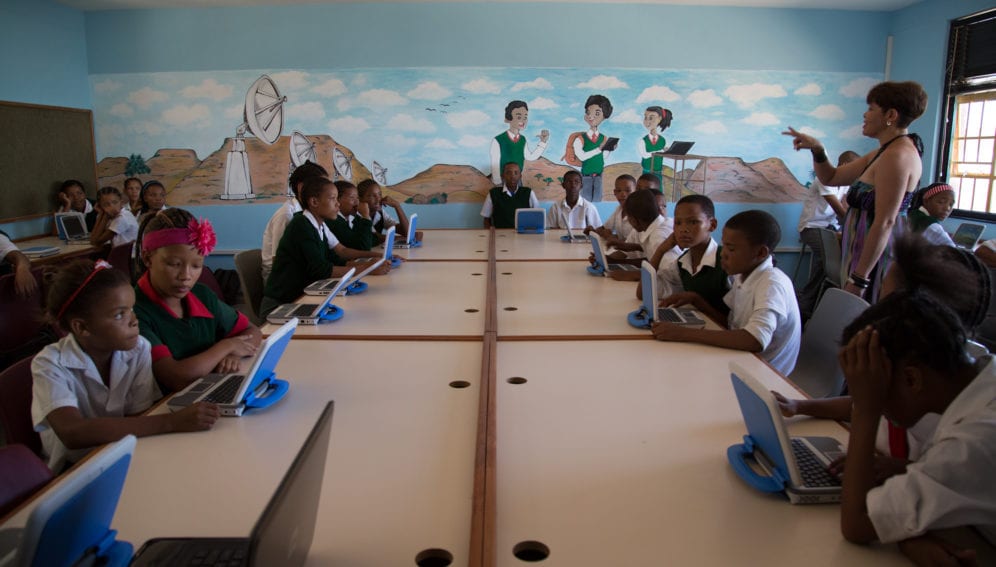By: Jon Spaull and Meera Senthilingam
Send to a friend
The details you provide on this page will not be used to send unsolicited email, and will not be sold to a 3rd party. See privacy policy.
[CARNARVON and SUTHERLAND] South Africa’s Karoo — “the land of thirst” in Khoisan — is a vast and sparsely populated plateau of scrub, grassland and occasional farmsteads covering 400,000 square kilometres. Towns are rare here: local people often travel hundreds of kilometres between settlements.
But the sparseness of human existence holds a strong attraction for one group of scientists — astronomers. Low levels of light pollution and scarce mobile phone signals and radio microwaves make it an ideal home for two world-class telescopes: the Southern African Large Telescope (SALT) and the Square Kilometre Array (SKA). SALT is the southern hemisphere’s largest optical telescope, and when construction finishes at SKA in 2030, the project — with sites in Sub-Saharan Africa and Australia — will form the largest telescope system on Earth.
At astronomy’s top table
In terms of hard science, the benefits for Africa have already been profound. The presence of these telescopes has seen the continent’s astronomical standing rise from being virtually non-existent before the projects began to ranking alongside facilities in Australia, Chile and the United States. South Africa, where most of the African SKA radio telescopes will be located, and the continent more broadly are now firmly on the world’s astronomical map.
Since it began fully operating in 2011, SALT has made many discoveries, including planets outside our solar system and dying stars — or supernovae. SKA’s South African segment will not be finished until 2030, but the first of 64 telescopes that will form part of a precursor to SKA was unveiled in March. The director of SKA South Africa, Bernie Fanaroff, says he is confident the project will one day produce Nobel Prize-winning astrophysics work.
“SKA offers support to help us become doctors, civil engineers and scientists, rather than people coming from outside and doing these jobs.”
Kyle Henderson, Carnarvon High School
But beyond assisting global research, what benefits do these complex projects bring to local communities?
The isolated towns and communities near SALT and SKA have myriad social problems: unemployment and illiteracy rates are high, and drug abuse, alcoholism and teenage pregnancy are rife.
The management teams at both projects have established plans to ensure the telescopes improve local conditions, livelihoods and education.
But, so far, what progress has been made?
SALT’s tourism take-off
SALT is located near the small town of Sutherland, in the western Roggeveld Mountains of the Karoo. Sutherland’s residents have lived through challenging economic times in recent years, with unemployment reaching 25 per cent in 2013, according to Statistics South Africa, the country’s national statistics service.
Figures from the South African Astronomical Observatory show the population has grown from 2,400 to 5,000 since SALT’s arrival, and the project has brought wide-ranging economic benefits. For instance, the local tourism industry was almost non-existent before the telescope arrived, but the town now sees around 14,000 visitors a year, many from outside South Africa.
“Before SALT, Sutherland was not known as a tourist destination and had two bed and breakfasts,” says Sivuyile Manxoyi, manager of SALT’s Collateral Benefits Programme, which was created to ensure the project helped local people. “But as a result of SALT, there are 40 bed and breakfasts and 18 guest farms for tourists to stay in.”
Education focus
Manxoyi says the project’s investment in local education and computer facilities has also reaped rewards. Teachers have been hired to boost science and maths teaching in the town’s two schools, and a community centre housing 36 computers was opened in 2012, providing local people with internet access and free daily workshops on computer literacy and networking.
The centre also functions as an after-school youth centre. And, at weekends, there are further workshops on internet banking, website development and animation and graphics, as well as health-related sessions to raise awareness of issues such as HIV/AIDS, substance abuse and the danger of drinking alcohol during pregnancy. SALT’s Collateral Benefits Programme has also been training local people in the use of robotic telescopes, with a view to employing them at the SALT site in the future.
Deswyn Lendfeld, a tourism student from the town, who volunteers at the community centre, says it has brought many local benefits. “The centre gives our community experience of technology and I’ve learned a lot about how computer and online networks work,” he says.
Manxoyi says that efforts to build links between local people and partner institutions — namely the University of Texas at Austin, United States — have also created educational dialogues and student training opportunities. The partnerships are coordinated by the SALT Foundation, which is administered by the international Hobby-Eberly Telescope Board, based at the McDonald Observatory in Texas, on which SALT’s design is based.
Struggling area
Nearly 250 kilometres north-east of Sutherland is the small town of Carnarvon, a traditional sheep-farming community and former mission station that lies about 80 kilometres from the South African SKA site.
Life here is hard. Many Afrikaans families moved to the area in the mid-nineteenth century to escape the strictures of British rule — a history not forgotten, with Afrikaner farmsteads handed down from generation to generation. But the majority of the population are classified as ‘coloured’ — the descendants of the country’s indigenous Khoikhoi, Bushmen and San people.
Alcoholism in Carnarvon is high and little appears to have changed here in the 20 years since the country’s first democratic elections in 1994. Most employment is on Afrikaner-owned sheep farms, but many of these have been abandoned in recent years. Those remaining have grown larger and more industrialised, leading to a fall in demand for labour. As a result, more than half of local residents are unemployed and many men spend their days drinking alcohol.
Like many rural areas of South Africa, educational achievement in Carnarvon is low, with the effects of the country’s under-resourced education system being felt acutely here. Further challenges include the disadvantaged social and economic backgrounds of many pupils, the illiteracy that is common among parents, and the difficulty of attracting teachers to this isolated area.
Minimising SKA’s disruption
The SKA project has been investing millions of rand in local development projects, including education and skills training. “When you come and disrupt an area with a project like this, you have to be sensitive to the local population,” says Jasper Horrell, general manager for science computing and innovation for SKA’s South African component.
SKA has been working with South Africa’s Department of Science and Technology to improve science and maths teaching in the local area. An e-schools initiative was launched last November to improve literacy and education. As part of this, SKA and its industry partners have provided donations worth around 2.5 million rand (US$234,000) to supply five local schools with computers loaded with learning materials, internet access, a mobile science cart containing a computer and digital projector, teacher training and bursaries. A community centre with 55 computers was unveiled at the same time in Carnarvon.
“We are putting in these new technologies to get local communities up to speed with science and technology in particular, so that in the future they can participate in the telescope at a higher level, rather than just laying bricks and building roads,” says Horrell. “There isn’t a strong culture of science and maths, so many initiatives involve lifting the population through education.”
SKA has also tried to sponsor students through university, although given the poor grades pupils in the area typically achieve, it says it has struggled to find suitable candidates.
But Hendrik Robyn, head of Carnarvon High School, is optimistic that the time will soon come when a former pupil returns to work at SKA as a scientist or engineer — a key goal for the school.
“I will be very proud the day when our first physicist, having qualified from this school via the SKA programme, reaches the site and starts working there as a scientist,” Robyn says. “That day is quite near: the current five students supported by SKA have the specific goal to go and study in those fields.”
One of these students is 17-year-old Kyle Henderson, who, inspired by SKA, says his ambition is to study engineering at Stellenbosch University.
“SKA offers support to help us become doctors, civil engineers and scientists, rather than people coming from outside and doing these jobs,” Henderson says. “So we must provide ourselves with education to qualify to work for SKA,” he says.
There has also been support for local firms. SKA says it offers regular business tenders to local construction and electrical firms, and that technicians from the area will be trained to maintain the telescope.
Local disappointment
Local people say there was great excitement about the project initially, with the old settler houses given a lick of paint, and a new boutique hotel and restaurant opening.
But Robyn says enthusiasm has now waned. “People have become quite disillusioned because they expected too much,” he says.
The anticipated flood of jobs has not materialised, with employment linked to SKA often just being in temporary construction posts. When fully operational, the site will only employ around 500 people, and the project will demand skills that most local people currently lack.
But Robyn believes there will be other economic benefits, including providing services to those visiting SKA. “That is where the community needs to think about starting a business,” he says.
Last year, SKA convened a community meeting with politicians and project representatives to talk through concerns about the initiative. Thousands of local people attended. In response to various demands, Fanaroff, the project’s director in South Africa, says he had to inform local people that he was here to build telescopes and had no budget to build houses.
Optimists in the town have talked about the fibre optics being installed turning Carnarvon into the centre of a new ‘Silicon Valley’. But, given the town’s isolation and sparse habitation being one reason why it was chosen as an astronomical site, this seems unlikely.
While SKA has already brought some benefits to the town, Carnarvon’s fortunes will not be reversed by SKA alone.














